The image above is a still from footage a Hizbullah drone recently shot of a key Israeli naval base in Haifa
Today, nearly nine months into Israel’s genocidal war in Gaza, the evidence is mounting that the country’s political-military leadership is on a path to serious defeat not only in Gaza but also more broadly in its decades-long contest against West Asia’s Iran-led “Axis of Resistance.” This fact is only just starting to receive some glimmers of recognition in the corporate media in the West. (Interestingly, one of the few to give it any public acknowledgment at all has been lifelong Zionist apologist Tom Friedman, who did so in some key portions of this June 18 column. Most of the other Zionist apologists who are deeply embedded in the US elite are still publicly spinning fairy tales of “an imminent defeat for Hamas.”)
The defeat towards which the Israeli leadership is currently hurtling is, as I noted, not only in Gaza, where numerous, apparently well-coordinated, cells of armed resisters have been making smart use of the rubble to which the Israeli military has reduced most of the Strip’s buildings, as well as their own tunnels, to launch well-prepared and often lethal attacks on Israel’s tanks, APCs, and snipers across the length and breadth of the Strip… and where Israel’s grotesquely genocidal attacks and other policies have notably failed to turn the population against Hamas. (Find more on the evidence for that key political fact, below.) But this defeat looms also in the ever-tense, but until now somewhat controlled, confrontation Israeli forces have been engaged in in the North, against Hizbullah fighters who are considerably more lethally armed than the Hamas fighters of Gaza and who have continued to upgrade their capabilities almost continuously in the 18 years since they last inflicted a decisive defeat on Israel’s military, in summer 2006.
And behind– or alongside– Hizbullah are the military capabilities of all the members of the Axis of Resistance, including Yemen, Iran, Syria, and other allies. Back in mid-April, these Axis of Resistance forces showed considerable sophistication when, retaliating against Israel’s April 1 assassination of of a key Iranian general in Iranian diplomatic premises in Damascus, they launched a well-choreographed array of scores of drones and missiles against Israel, with some of the earlier drones “clearing the way” for the arrival of missiles at key, previously identified Israeli military facilities.
More recently, earlier this week, Hizbullah displayed its surveillance/recon capabilities by releasing a nine-minute video one of its drones had taken as it lazily circles over key Israeli military facilities in and around Haifa.
Israel is a very abnormal kind of polity. It is less a society with a military attached than a vast military-industrial complex with a state and an artificially constructed society somewhat tenuously dangling from it. Hence, the looming multi-pronged defeat now hanging over the country’s military threatens to bring the whole of that state and society crashing down with it. Already, there are numerous augurs of that broader collapse, including the openly pursued in-fighting between the military’s chief staff (and his spokesman) and Prime Minister Netanyahu.
Israel’s experiment in colonial statehood was, we should recall, launched only after, on a world level, Western colonialism was already significantly starting to recede, in India and elsewhere. The collapse/implosion of this experiment will likely not occur in any peaceable or orderly fashion; and it may not happen soon. But when it does, as now seems increasingly likely, it will overturn the balance of power within West Asia and far beyond. Given that this small state (or more precisely, its military) controls an extremely well-developed nuclear arsenal and that during the Gaza crisis it has become closer than ever to the (anyway fading) global hegemon, the United States, the ripple effects from its implosion will be far-reaching indeed.
Plus, there is disturbingly little prospect that– even should the states that represent the Global Majority prove willing and able to push back against the US-Israel axis and to swiftly end Israel’s 57-year military occupation of Gaza– the fate of Gaza’s surviving population can be easily or swiftly remediated. (Though we can continue to hope that it can, and we should all work hard to push the U.N. to speedily end Israeli’s genocidal occupation of Gaza, as a vital first step.)
In this essay, I cannot explore the many dimensions and repercussions of Israel’s increasingly evident military defeat. Instead, I want to start by surveying the growing body of evidence that indicates that this is indeed the path that Israel is on.
Israel vs. Hamas
Wars are not”won” or “lost” in only military ways. Crucially, they are won or lost at the level of morale and capabilities, broadly defined. In the big wars of the 20th century, the Allies won WW-1 when they had hit Germany’s capabilities hard enough to persuaded the German high command to sign a surrender. In WW-2, the Allies over-ran Germany completely (from both East and West), and though individual German commanders surrendered in various places, by VE-Day there was no central high commend left: the whole country had been over-run. On the Pacific front, the United States used two nuclear attacks against Japanese cities to “persuade” Hirohito to surrender (and he got to keep his throne.) In China and Korea, the U.S. and its proxies fought the opposing (Communist) side to a draw and in other wars, the U.S. side was able to force the opposing polity to accept Washington’s nominee as ruler. But then came a clear U.S. defeat in Vietnam, despite overwhelming military superiority and readiness to use violence; and similarly, in many other countries of the Global South, including Algeria, Kenya, South Yemen, etc, the national liberation forces were able to withstand the colonial powers’ use of terrible violence and to win their liberation.
Robert Pape has an insightful piece in Foreign Affairs today under the stark headline “Hamas Is Winning: Why Israel’s Failing Strategy Makes Its Enemy Stronger.” I was fascinated by this piece– not just because I have increasingly come to the same conclusion myself over recent months, but also because I have considerable respect for Pape, who’s an out-of-the-box thinker who got a lot of things right in his earlier analyses of the U.S. wars in Iraq and Afghanistan.
Also, let’s face it: Foreign Affairs! That is not a trivial platform to be publishing such a thought-provoking piece– and the fact that they did so indicates that Pape’s thinking on this matter is shared, or at least sympathized with, by a non-trivial portion of the U.S. foreign-policy elite. (Not that the corporate media are telling the public much about this, at all.)
Throughout his piece, Pape makes numerous comparisons with the failed U.S. policies in Vietnam and Afghanistan– including the misleading focus that military and political leaders in those other colonial wars placed on “body counts.”
Israel says 14,000 of the estimated 30,000 to 40,000 fighters Hamas had before the war are now dead, while Hamas insists it has lost only 6,000 to 8,000 fighters. U.S. intelligence sources indicate the real number of Hamas dead is around 10,000.
A focus on these numbers, however, makes it hard to truly assess Hamas’s power. Despite its losses, Hamas remains in de facto control of large swaths of Gaza, including those areas where the territory’s civilians are now concentrated. The group still enjoys tremendous support from Gazans, allowing militants to seize humanitarian supplies almost at will and easily return to areas previously “cleared” by Israeli forces.According to a recent Israeli assessment, Hamas now has more fighters in the northern areas of Gaza, which the IDF seized in the fall at the cost of hundreds of soldiers, than it does in Rafah in the south.
He concludes that,
the most crucial source of power of Hamas and other militant nonstate actors commonly referred to as “terrorist” or “insurgent” groups is the ability to recruit, especially its ability to attract new generations of the fighters and operatives who carry out the group’s lethal campaigns and are likely to die for the cause. And that ability to recruit is rooted, ultimately, in a single factor: the scale and intensity of support a group derives from its community.
And he notes that:
To assess the group’s true strength, analysts should consider the various dimensions of its support among Palestinians. These include its popularity as compared with its political rivals, the extent to which Palestinians view Hamas’s violence against Israeli civilians as acceptable, and how many Palestinians have lost family members in the ongoing Israeli invasion of Gaza. These factors, more than material ones, provide the best gauge of Hamas’s power to conduct a protracted terrorist campaign going forward.
Surveys of Palestinian opinion can help assess the extent of community support for Hamas. To account for the challenges of surveying the population in Gaza since October 7, the Palestinian Center for Policy and Survey Research (PSR), a polling organization established in 1993 after the Oslo accords that collaborates with Israeli institutions, included interviews of displaced people in temporary shelters and roughly doubled the usual number of interviewed respondents given the uncertain and changing population distributions in the territory.
Five PSR surveys from June 2023 to the most recent, completed in June 2024, present a striking finding: on virtually every measure, Hamas has more support among Palestinians today than before October 7.
I have a major problem with the way Pape keeps referring to Hamas as a “terrorist” organization. At one point he writes: “Hamas is a political and social movement with violence at its core.” Based on my own lengthy studies of Hamas– and on the series of far-reaching conversations that Rami Khuri and I recently conducted with five fine experts on the movement– I would rather say that Hamas is an Islamist/nationalist political and social movement deeply embedded in all the major communities of Palestinians throughout West Asia that has a clear national-liberation goal and an increasingly clear plan for how to attain it (in stages, if necessary); and that over its 37-year history the movement has used violent tactics in some periods and eschewed their use in other periods when its leaders felt that other tactics would be more helpful in realizing their national-liberation goals..
Pape was right, however, to draw attention to the PCPSR’s poll results, and to the lengths that polling organization has gone to, to try to continue its decades-long series of opinion polls even amidst the chaos of displacement and attacks in Gaza.
Pape refers only obliquely to the political leanings of the PCPSR’s leadership, by noting that the org “collaborates with Israeli institutions.” For many years now, though, the Ramallah-based PCPSR and its head, Khalil Shikaki, have been fairly closely politically affiliated with Fateh, who are Hamas’s main rivals in the Palestinian political arena…
That makes the organization’s latest findings (full PDF here) about the increase in Hamas’s support since October 7 even more notable.
Here are a few of them, which you can find easily in the PDF:
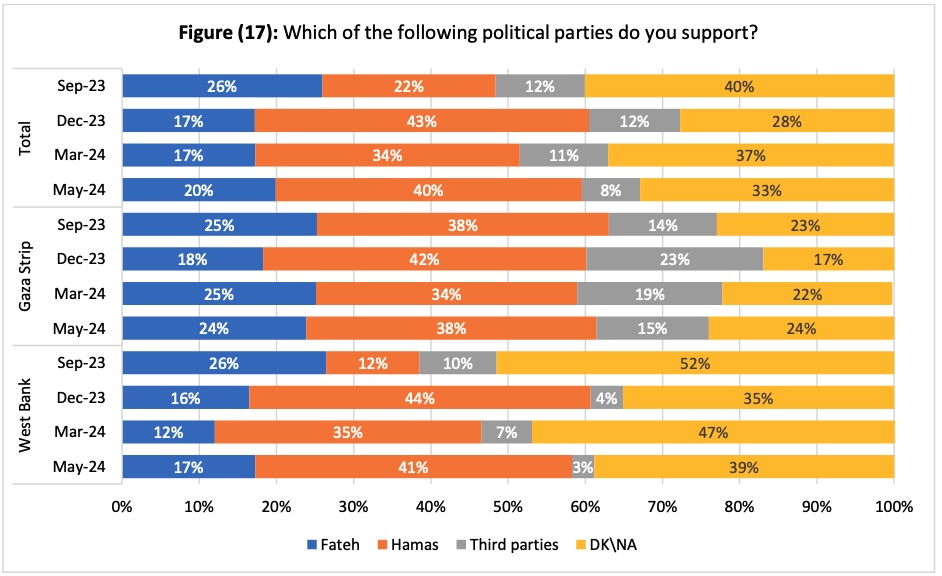
Always worth noting when you read PCPSR survey reports: Shikaki only polls those Palestinians who have been allowed by Israel to remain at liberty within the occupied West Bank (including East Jerusalem) and Gaza. He does NOT ever include that much larger number of Palestinians (maybe 12 million?) who have been forced through mass expulsions in 1948 and 1967 and through economic/social suffocation by the Israeli occupation since 1967 to live in exile. Of course those exiles never lost their claims to homes properties or crucially also the exercise of their political rights within Palestine. It is always worth remembering that…
But there, in the PCPSR report’s Figure 17 (above) you have an increase in its findings for OPTs-wide support for Hamas from 22% in September 2023 to 40% in May 2024— with that increase actually being much greater in the West Bank, while in Gaza there was little change.
Then, in Figure 10 we have this– a measure of “satisfaction with the performance of various actors in the current war”:
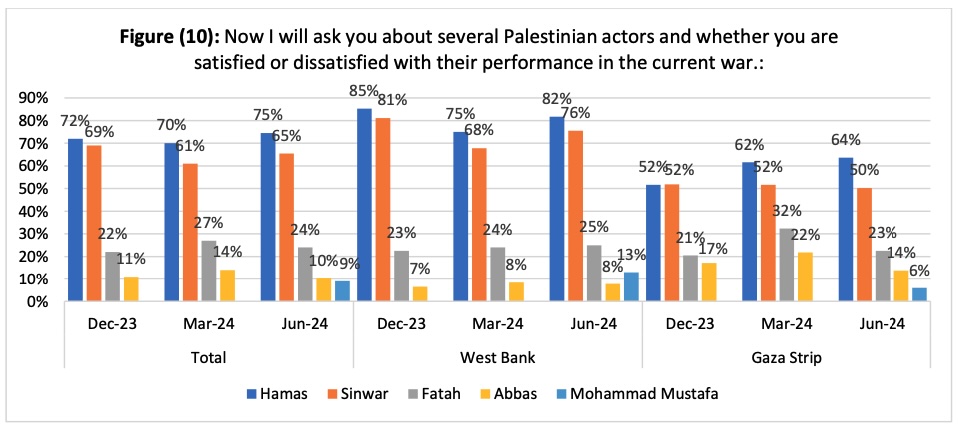
(Shikaki uses a confusingly different mix of colors there. No matter.)
Here we have a noticeable increase in satisfaction expressed by Gazans for Hamas between , from 52% in December to 64% in May. To me, that’s very significant, since several members of the Israeli elite have been pretty clear in arguing that the harshness of Israel’s assaults against Gaza have been aimed at trying to turn the Gaza Palestinians against Hamas. See, for example, the comments made by Israel’s former dep[uty national security adviser Chuck Freilich toward the end of this important Al-Jazeera documentary, back in March.
But that has not happened and it is extremely unlikely that it will happen in the future. My parents lived as newlyweds through the Blitz in London. I could have told Chuck Freilich a bit about the “rally round the flag” effect when a society is under intense attacks from outsiders…
So here are a couple more items from the latest PCPSR poll. First, the reactions of the OPTs Palestinians to various suggestions the Israelis or Americans have made regarding the post-conflict governance of Gaza:
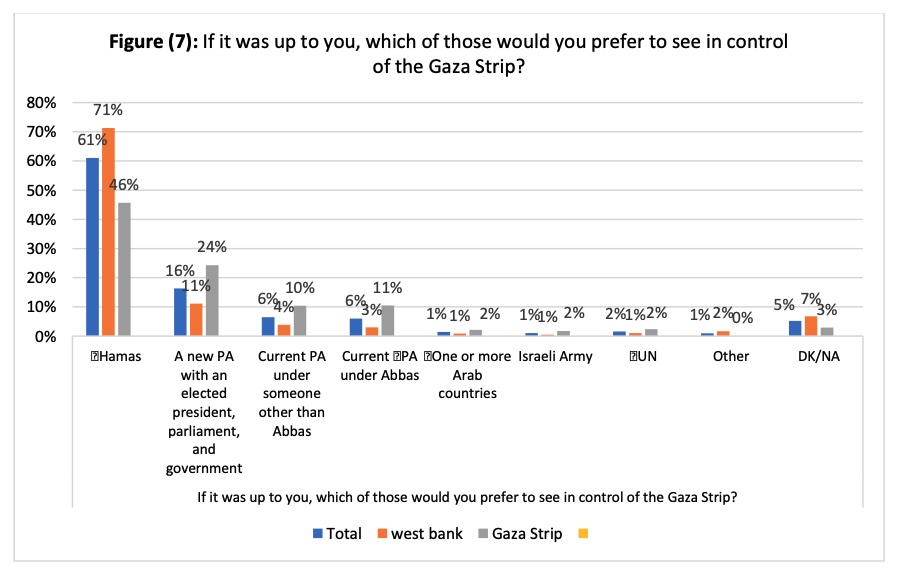
So, OPTs-wide there was a clear preference for undiluted Hamas rule over PA rule in any form: 62% to 28%. And then 1% for “One or more Arab armies”, 1% for the Israeli Army, and only 2% for the UN.
Also interesting there: the Gaza-only results: 46% support for Hamas rule vs. 45% for PA rule in some form or format– with the majority in that latter group (24% of total) opting for “A new PA with an elected president, parliament, and government.” FYI this latter path is also, as I understand it, the preference of Hamas itself, though Pres. Abbas and his henchfolk from Fateh/PA steadfastly refuse to allow such new nation-wide elections…
And finally this unambiguous message for Pres. Abbas, from Shikaki’s Figure 16:
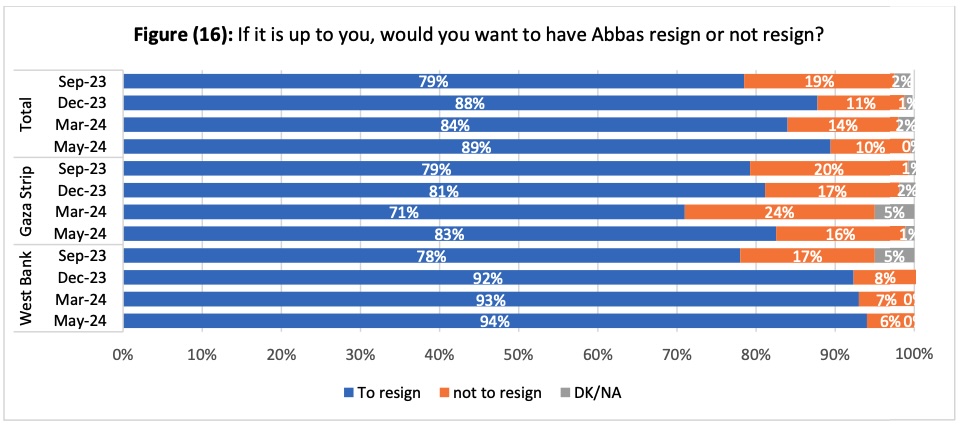
Israel vs. Hizbullah/Iran/etc.
I don’t have space here to review all the shifts in the subtle “balance of deterrent terror” that has existed between Israel and Hizbullah over the past decade– shifts that understandably accelerated after October 7. I have written elsewhere, too, about the ways in which Israeli leaders have since October 7 used threats that they might escalate against Hizbullah/Lebanon/Iran as a way to, in effect, blackmail Washington into giving them everything they feel they need in order to continue their genocide in Gaza.
However, what happened in April of this year represented a sea-change in the balance of (deterrent) terror between Israel and Iran. First, as noted above, on April 1, the Israeli high command (presumably with the acquiescence of, or perhaps at the urging of, PM Netanyahu?) decided to breach diplomatic norms and, undertaking one of their frequent violations of Syria’s national airspace, they fired missiles at a gathering in an Iranian diplomatic compound in Damascas and killed a highranking Iranian general along with, reportedly, several of his aides.
Recall that in January 2020, Pres. Donald Trump did something very similar (but without the violation of the Vienna Convention) when he ordered the U.S. military to assassinate Gen. Qassem Soleimani, the head of the IRGC, when he was on a visit to Baghdad… And Trump, essentially, “got away with” that act of blatant aggression– as he has gotten away with so many other gross violations in his life.
This time, the Iranians had a strong response. They used the next two weeks to plan an elaborate, multi-pronged operation that sent a reported total of some 300 projectiles of various sizes, speeds, and explosive force against military targets in Israel from several different parts of West Asia.
Israel, the United States, and their allies used those two weeks to plan the best defense for Israel that they could. That involved U.S. Centcom commanders apparently taking the lead in coordinating the use of U.S. surveillance planes and U.S., Israeli , and Jordanian missile-defense and air-defense systems, of Jordanian and apparently some Iraqi airspace– oh and I think they also brought the British RAF into the operation a little too… And through this immense show of air-defense and missile defense capabilities the US-led force reportedly managed to intercept some 84% of the projectiles sent to Israel from Iran, Iraq, Yemen, and elsewhere… But that meant that around 18 projectiles probably got through, and those that did caused some noticeable damage to Israeli military bases but none to civilians except one young Palestinian-Israeli girl who was lightly injured. (Israel’s heavily censured media did not report on any casualties among their military personnel. So we do not mknow if any were inflicted.)
The Iranians named their response to the Damascus killings “Operation True Promise”. It had two main effects. Firstly, it demonstrated that the Iranians’ ability to penetrate the multi-layered defenses that Israel and its allies had erected around Israel was not trivial– and neither was their ability to coordinate a very complex action against Israel from multiple locations. Secondly, it underlined to military planners in Israel, the United States, and everywhere else the heavy degree of reliance that Israel had on military help from Washington.’
… More recently, on June 18, as some Israeli and American analysts were warning that Israel might “feel obliged” to launch an escalation against Hizbullah in Lebanon, Hizbullah published a notable nine-minute video shot by one of its drones loitering over a number of military and civilian facilities in and around the northern Israel port of Haifa. The whole video can be found on Telegram. Al-Jazeera published a short excerpt here. Here are a couple of screengrabs from the longer video:
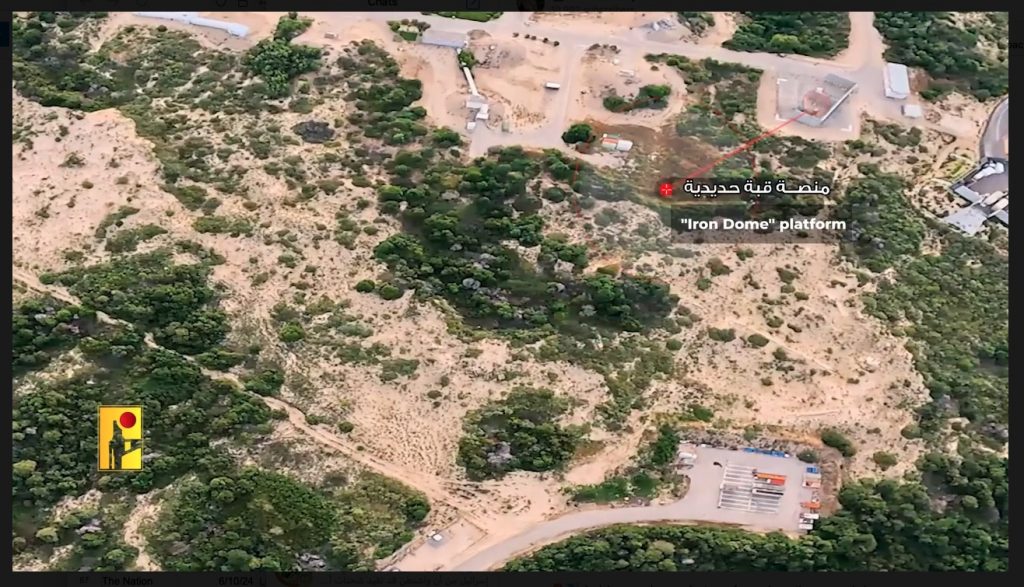
If, as seems likely, that actually is a platform for one of Israel’s much-vaunted “Iron Dome” missile-interception systems, then the fact that a Hizbullah drone can lazily fly over it, apparently undetected, and then return safely to base– or perhaps, it was transmitting its footage back to its base in Lebanon even while it was aloft– looks extremely embarrassing for Israel.
And here’s a screengrab from footage of the Haifa naval base:
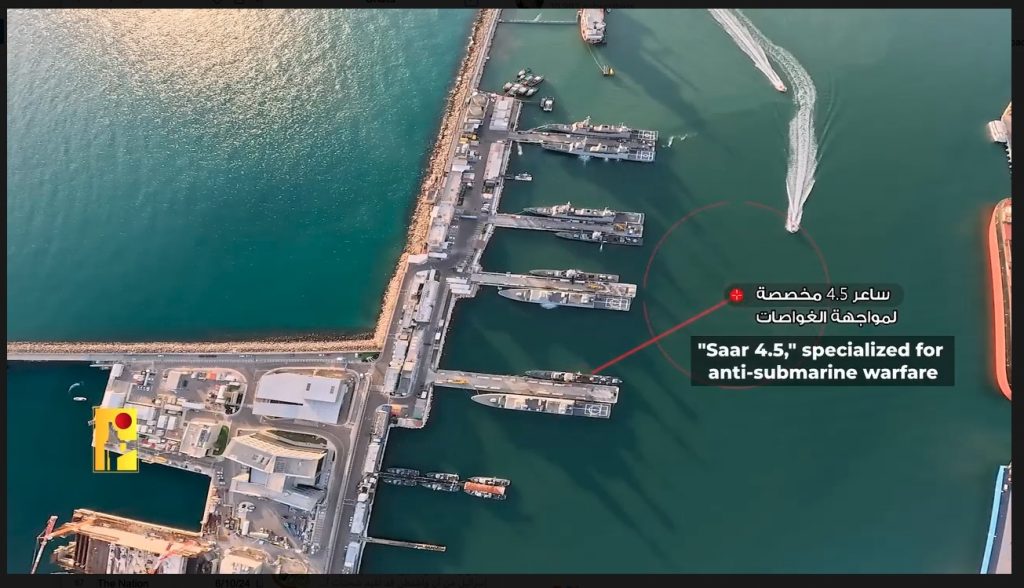
Here again, the naval base looks pretty undefended…
In the video, the drone was clearly sent around (and captured good clear footage from) a number of of sizeable and strategically important military and military-industry sites. It was sent around some key pieces of society-wide (civilian plus military) infrastructure: a power station, a petrochemical complex, an oil-storage tank farm, and so on. And it also lingered over some well-identified residential neighborhoods and a shopping mall.
The Israeli news-site Ynet reported June 18 that, “The Defense Ministry allocated hundreds of millions of shekels to develop a technological solution for intercepting such aircraft and stated it could be operational within three months.” Uh-oh.
The message Hizbullah wanted to send to the Israelis by releasing the footage was clearly something like this:
“You enacted your ‘Dahiyeh Doctrine’ back in 2006, flattening entire neighborhoods of southern Beirut and numerous key pieces of national infrastructure like bridges, a power station, etc. And you threaten to do the same to us again– while you are also, right now, enacting the ‘Dahiyeh Docrtine’ big-time against Gaza. But if you do so against us once again, your Dawahi (neighborhoods) in and around Haifa and your other major cities can be just as vulnerable to us as ours are to you.”
Hizbullah head Hassan Nasrallah underlined that message in a big public speech on June 19.
Growing recognition from Israeli and pro-Israeli analysts of the strategic bind Israel is in
It is not only Tom Friedman who has started calling out loudly about the strategic black hole into which Israel’s leaders seem to be taking the country. But I can’t resist starting off with his recent piece, which in the print version of the NYT was titled “Israel Is in Existential Danger.” (It had a different headline online.)
Friedman hangs most of his argument on the agreement he expresses with the views of former Israeli PM (and before that, chief of staff of the Israeli armed forces) Ehud Barak, who warned that if the Netanyahu government remains in power,
Israel will not only find itself stuck in Gaza — with Hamas still able to fight and no Arab partner to help Israel out of there — it will also most likely find itself ‘in an all-out war with Hezbollah in the north, a third intifada in the West Bank, conflicts with the Houthis in Yemen and Iraqi militias in the Golan Heights and, of course, conflict with Iran itself’.
Tom’s policy prescription is intriguing:
This is ultimatum time. Biden should be telling Israel that it should accept Hamas’s key demand: Totally end the war now and withdraw from Gaza in exchange for the return of all Israeli hostages. Israel cannot think straight while Hamas holds its people.
…
Yes, yes, I can hear the criticism from the war hawks right now: “Friedman, you would let Hamas’s leader, Yahya Sinwar, come out of his tunnel and declare victory?”
Yes, I would.
…
I believe that the morning after the morning after Sinwar emerges from his tunnel, many Gazans will want to pummel him for the disaster he has visited on them. And if not, Sinwar and Sinwar alone will be responsible when the water doesn’t flow, when the building materials don’t arrive, when the sun doesn’t shine — not Israel. And if he is so foolish as to restart the war with Israel or attempt to smuggle in weapons instead of food and housing for his people, it will all be on him.
Sadly, if all this war does is buy Israel another long timeout with Hamas, well, maybe that’s all that’s possible….
Well, I disagree that “Sinwar”, or more broadly the Hamas movement of which he is a part, would find themselves alone in undertaking the truly mammoth task of rehabilitating and starting to rebuild Gaza. If– as I have been urging non-stop since November– the big powers of the world can succeed in having the U.N. Security Council regain its rightful place as the lead body overseeing a rights-based termination of the decades-long conflict conflict in historic Palestine, then surely the end of the conflict will bring an end to Israel’s 57-year occupation of Gaza; and all the Palestinian national movements including Hamas can count on the generous support of very experienced U.N. bodies as they work to rebuild Gaza.
But still, I find it interesting and significant that even Tom Friedman is today arguing for the speedy conclusion of a ceasefire agreement in Gaza that will necessarily keep Hamas in place there. I only wish he had spoken up for this around 8.5 months ago.
I also have a whole list of Israeli analysts– people who have a lot more military/strategic experience than Tom Friedman– who have started to cry out about the dire military/strategic situation their country finds itself in.
Here is Col. (res.) Ron Tira from the rightwing think-tank BESA, asking “Israel’s Conduct of the War After October 7: Is This Carelessness or Wrongdoing?“
Here is an English-language summary of an interview that Reserve Major General Yitzhak Brik recently gave to an FM station in Israel. “We have reduced the army’s capability over 20 years to the point where it cannot defeat Hamas,” he is reported as saying.
As for the northern front with Lebanon, Brik stressed that any decision by the current Israeli government under the leadership of Netanyahu “will bring catastrophe to Israel.”
He said that the Israeli military cannot currently intercept Hezbollah’s missiles and drones. He then went on to question what would happen in occupied territories if thousands rather than dozens of rockets, drones, and missiles were fired at Israeli positions.
As for the reliably anti-Netanyahu newspaper Haaretz, its pages are filled with warnings from specialists in military affairs,in national politics, infrastructure needs, and other key fields– including, periodically, former PM Ehud Barak– to the effect that the country’s strategic-command system and its entire broader political decisionmaking system are well on their way to breakdown.
… So there you have it. Nearly nine months into Israel’s genocide in Gaza, PM Netanyahu and many war-hawks in the pro-Zionist movement worldwide continue to call for the conflict (that is, genocide) to be allowed to continue “until Hamas is destroyed.” But meanwhile what we see is that Hamas has remained resilient and indeed increased the level of its support from the Palestinians, while it is wealthy, hyper-armed– indeed, nuclear-armed– Israel that is falling ever deeper into disarray.

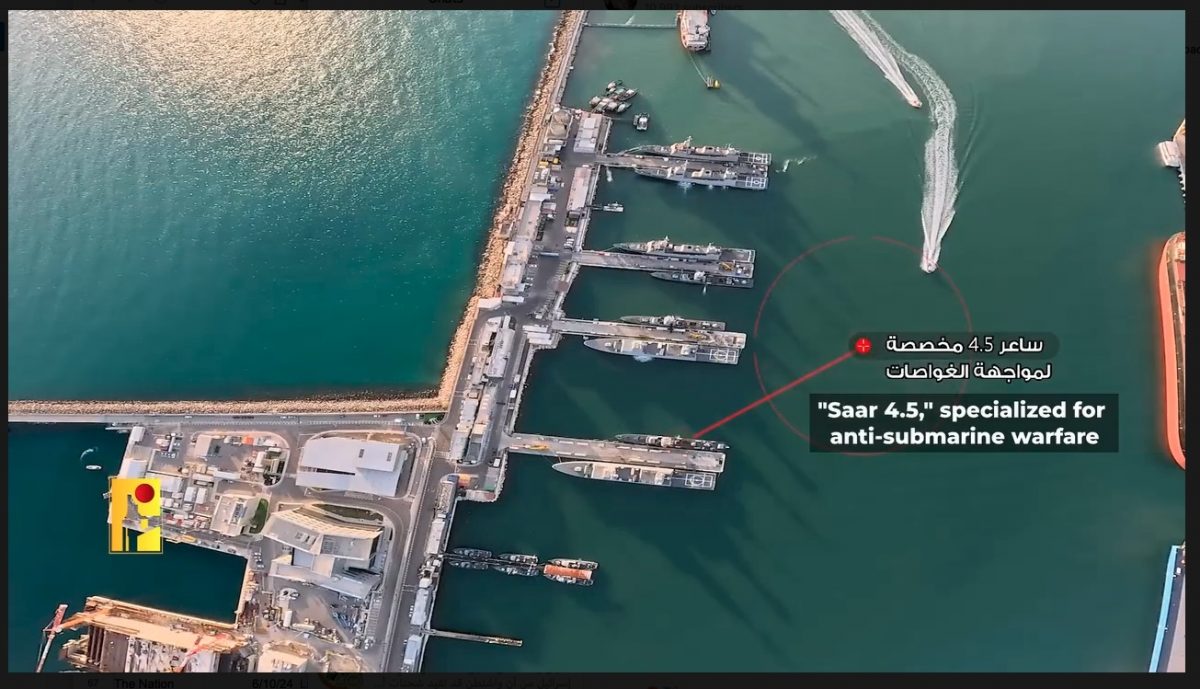

This is excellent Helen, thank you. It’s time to put Israel’s self-defeating campaign “to eliminate” Hamas in the broader framework of the catastrophic endgame of Zionism itself, and to join, as you point out, the growing ranks of analysts essentially predicting the end of Israel as we know it. The “Zionist apologists” like Tom Friedman are even joining in, of course in their incomprehensible unwillingness to let go of the idea of a Jewish state, saying that Israel must get smart and change course in order to preserve that very project. You may have missed Peter Beinart’s recent piece — same story. https://peterbeinart.substack.com/p/apocalyptic-thinking-and-israels
Beinart leads with his usual liberal Zionist cant about freedom equality for Palestinians, but in the piece he lays out the disaster, in “apocalyptic” terms, urging that Israel turn away from its fixation on military solutions. So he gets what you get — even as he continues to be unwilling to finally let go of his death grip on the Zionist dream and his liberal fixation on “if we could just learn to be nice to the Palestinians, we could save this racist colonial project.
“I don’t feel like when I look at American discourse, American political discourse, American Jewish discourse, I don’t see an effort to really or push Israelis, to challenge Jewish Israelis, to ask them to think outside of their own political terms—again, in an Israel right now where basically the terms of political debate run from the very far right to essentially the center right, right, in which people who genuinely see Palestinian freedom as the essence of trying to provide Israeli security, those voices among Jewish Israelis are basically off the table. And that’s part of what frightens me so much about this moment.”
Thanks for that, Mark. I don’t follow Beinart closely, so I’m glad you do it for us! I see him, like Tom Friedman, acting as a self-appointed gatekeeper of the U.S. public discourse on behalf a (self-defined) “liberal” form of Zionism– the Zionist settler-colonial project in Palestine being one that neither man is willing to fundamentally question or abandon. But with these differences: Friedman actually has a *far* greater familiarity than Beinart with the regional dynamics of West Asia and the global dynamics of the Palestine Question; and he has a far deeper resumé and bigger platform.
Fwiw when I was a young foreign correspondent in Beirut in the late 1970s, Tom Friedman came to join our ranks, working first of all as I recall, for UPI before he joined the NYT. Like the vast majority of people working there for U.S. media in those days (but not me), he never bothered to learn Arabic and was always trapped in the colonial-style bubble of reliance on the cadre of “native informants” who were then called “fixers”– oh, and also on the briefings he received from the U.S. and other Western embassies. ..
Anyway, thanks for the informative little excerpt from Beinart.
Helena, all do respect to your great work, I don’t know why you find it necessary to weigh on someone you don’t follow, know, or understand. Essentializing Beinart as a Zionist (Mark) might make someone feel better/more radical about themselves, but unfairly attacks one of the foremost Jewish proponents of Palestinian liberation. Further, he has evolved from his previous two-state fixation and continues to learn as well as teach, and hosts many brilliant speakers on his weekly zoom. I’d appreciate it if people would put their efforts into their work instead of tearing down that of others.
Dave, just in case it matters to you, I’ve followed Beinart’s work for many years, but haven’t done so very much recently. (Busy with other, much more urgent things.)
There is something getting stated in various ways on various blogs that bears repeating for emphasis. Here it is again in summary: the Israelis are being reduced through economic, military and diplomatic means, but this does not occur in a vacuum or in isolation. The United States has been Israel’s prime benefactor, providing oodles of money, military support, and diplomatic cover through vetoes in the United Nations. The United States Congress Critters and President must also be worn down to make changes.
The situation can be crudely compared to the situation in Ukraine where Ukraine and its military are being broken down after years of warfare. At the same time, Western support and resolve that has kept the war going is eroding. The nature of the attrition in the two places is, of course, somewhat different with more intense warfare going on in Ukraine. But the general pattern from Ukraine is likely in Israel’s future on its current course. Like Ukrainian leadership over the past two years, Israeli leadership cannot back down without giving up goals that have become enshrined beyond reason.